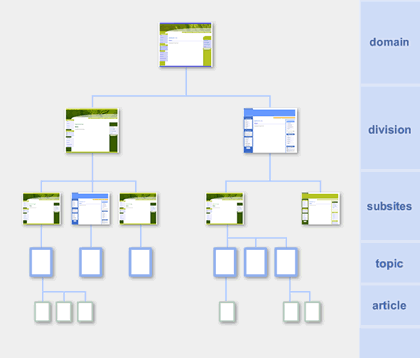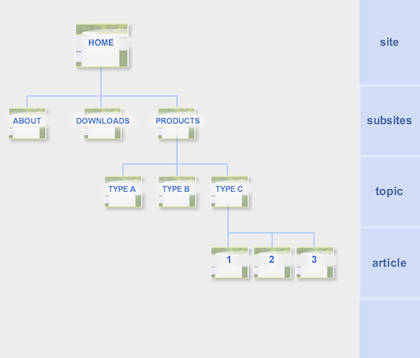 Sites and site structures
Sites and site structures
Notanant sites come with structure, and from this structure really powerful site management tools like menus that automatically update, %% components that enable you to bring content from across your site (like news, or pictures, or products) into different pages automatically can happen.
A site contains information/pages in content areas - eg content area can be a special type, such as news, gallery or articles. The site also contains members, a calendar, access permissions, rules about privacy, products, images, components and the special ingredient, subsites.
This special repeating structure that makes them extremely scalable, yet also easy to navigate. All sites and subsites have a home page, which stays at the top of the structure. Infomation can be placed into articles these are then organised into content areas. The content area controls how the articles contained are displayed. Some examples of content area uses are galleries, a list of news items, a forum, a blog or just a list of articles. You can also control who can see and who can add information to each content area.
The scalability of Notanant comes from the ability to connect sites to other sites and substies. So, if you have a service package of more than one site then you can add subsites beneath the top site. Each subsite also contains content areas so you can quickly build deep and well-structured sites.
When creating a new site on Notanant, it is important to get the structure right. Although the structure can be rejigged at will and parts of the site cut and pasted around, if the structure is arranged inappropriatly users can find it difficult to navigate through the site. Things can always be moved afterwards but editing delays can be avoided if things are right from the beginning.
Description of Levels
Site/Domain
This refers to your main site on Notanant. You can chose components and templates at this level to affect the entire site and underlying pages. Most administration changes are done at this level, like permission settings and adding new members.
Subsites
Notanant sites can be divided up into subsites. Subsites can have their own members and settings. An example of a typical subsite application would be 'products' , this would then contain different product catagories in the form of content areas (see structural example below).
A special form of subsite is called a Division which is used for particularly large sites to help navigation. When a site contains many subsites, a division can be used to divide the site into large areas.
Content Areas
Content areas are used to divide sites into content areas. If the subsite was company products, then the content areas might be product ranges. Each site or subsite in your structure can have it's own content areas and articles.
Articles and content areas content
The lowest level to the site's information structure, articles make up the content and infomation pages of a site and are nested inside content areas. Articles can be pictures in a gallery, posts in a forum, news items etc depending on how you have the content area set up.
Basic level rules
Subsites
- Main permissions controlled from here
- Site style controlled from here
- Can be contained by or contain other subsites
Content areas
- Used to group and display articles
- Different listing style options available for the articles contained
- Options can be set to turn a content area's articles into news, galleries etc.
Articles
- The lowest level of page
- Held inside a content area
- Can hold PDFs and other attachments
- Can be used as galleries or news items (if set by topic)



